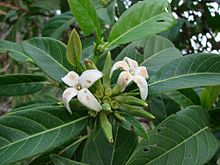Alibertia edulis
| Alibertia edulis | |
|---|---|

| |
| Alibertia edulis leaves and flowers | |
| Scientific classification | |
| Kingdom: | Plantae |
| Clade: | Tracheophytes |
| Clade: | Angiosperms |
| Clade: | Eudicots |
| Clade: | Asterids |
| Order: | Gentianales |
| Family: | Rubiaceae |
| Genus: | Alibertia |
| Species: | A. edulis
|
| Binomial name | |
| Alibertia edulis (Rich.) A.Rich. ex DC.
| |

Alibertia edulis is a species of tree in the family Rubiaceae. It is native to the tropical forests of the Americas.[1]
Description[edit]
Alibertia edulis is an evergreen dioecious tree up to 25 feet (7.5m) tall at maturity, with light brownish bark and opposite, ovate, dark green leaves that have a smooth margin. The flowers are tubular to trumpet-shaped, white, hairy, in 4-8" panicles, with 4-5 petals. The fruit is yellow, egg-shaped, ovate, edible, and made into jam or juices. The fruits are collected from trees in the wild, as this species is seldom cultivated.[2]
References[edit]
- ^ Grandtner, M. M.; Chevrette, Julien (2013). Dictionary of Trees, Volume 2: South America: Nomenclature, Taxonomy and Ecology. Academic Press. pp. 22–23. ISBN 9780123969545.
- ^ "Alibertia edulis". bananasraras.org (Rare bananas). Retrieved 16 January 2015.
